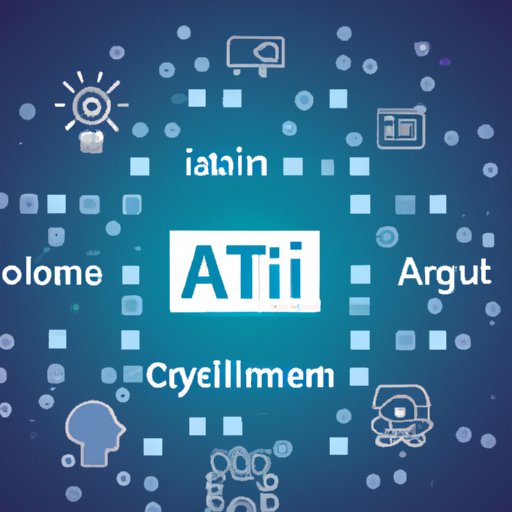Introduction
What is Artificial Intelligence (AI)? The term often conjures images of robots and computers performing complex tasks, but the reality is much more complex. AI has been around since the 1950s and has evolved significantly over the years. It is now used in many aspects of our lives, from healthcare to transportation. This article will explore the definition of AI, how it works, its potential, and its ethical implications.
Exploring Artificial Intelligence: A Comprehensive Definition
The definition of AI can be difficult to pin down, as it covers a wide range of technologies and applications. Generally speaking, AI is an area of computer science that focuses on creating machines that can think and act like humans. These machines are designed to learn, adapt, and solve problems. AI systems use algorithms, programming languages, and data to carry out their tasks.
AI can be divided into two main categories: weak AI and strong AI. Weak AI, also known as narrow AI, is designed to perform specific tasks, such as facial recognition or language processing. Strong AI, also known as general AI, is designed to mimic human intelligence and solve more complex problems.

The Basics of Artificial Intelligence: An Overview
The history of AI stretches back to the 1950s. At the time, computer scientists sought to create machines that could think and reason like humans. Since then, AI has advanced significantly, with machines now able to perform complex tasks, such as medical diagnosis and stock market forecasting. AI is now used in many industries, from healthcare to finance.
Common AI applications include natural language processing (NLP), computer vision, machine learning, and robotics. NLP is used to process spoken and written language, while computer vision is used to analyze visual data. Machine learning is used to identify patterns in data, while robotics is used to control machines and robots.
AI has numerous benefits, including increased efficiency, reduced costs, and improved decision-making. However, there are also some drawbacks, such as bias, privacy concerns, and job displacement. As AI continues to evolve, it is important to consider both the potential benefits and risks associated with these technologies.

Artificial Intelligence: What It Is and How It Works
In order to understand AI, it is important to understand the components that make up this technology. AI systems are composed of algorithms, programming languages, and data. Algorithms are sets of instructions that tell a computer how to carry out a task. Programming languages are used to create algorithms and control the behavior of machines. Data is used to train AI systems and improve their accuracy.
There are different types of AI algorithms, including supervised learning, unsupervised learning, and reinforcement learning. Supervised learning algorithms are used to classify data, while unsupervised learning algorithms are used to detect patterns in data. Reinforcement learning algorithms are used to optimize decisions based on rewards and punishments.
Programming languages used for AI include Python, Java, C++, and R. Python is a popular choice for AI development due to its easy-to-learn syntax and extensive libraries. Java and C++ are both efficient languages for AI development, while R is used for statistical analysis.
Artificial Intelligence: A Beginner’s Guide to the Definition
When exploring the definition of AI, it is important to understand the basic concepts. AI technologies are designed to simulate human intelligence and automate processes. AI systems use algorithms, programming languages, and data to carry out their tasks. There are different types of AI algorithms, including supervised learning, unsupervised learning, and reinforcement learning.
It is also important to understand the technologies used to develop AI. Popular programming languages include Python, Java, C++, and R. Each language has its own advantages and disadvantages, so it is important to choose the right language for the job. Additionally, AI systems rely on large amounts of data to function properly.
Examples of AI in action include facial recognition, autonomous vehicles, and virtual assistants. Facial recognition is used to identify individuals, while autonomous vehicles use AI to navigate roads. Virtual assistants use AI to understand and respond to voice commands.

Artificial Intelligence: Understanding its Meaning and Uses
Once you have a basic understanding of AI, it is important to explore its potential. AI technologies have the potential to revolutionize many industries, from healthcare to finance. AI systems can be used to automate processes, reduce costs, and improve decision-making. Additionally, AI can be used to uncover insights from large datasets and provide personalized experiences for customers.
However, it is important to consider the ethical implications of AI. AI technologies can be used for good or ill, depending on how they are implemented. It is important to ensure that AI systems are transparent, accountable, and free from bias. Additionally, it is important to consider the impact of AI on employment, as these technologies may displace workers.
As AI continues to evolve, it is important to consider its implications for the future. AI may change the way we work, live, and interact with one another. It is important to ensure that AI is developed responsibly and used for the benefit of society.
Conclusion
In conclusion, Artificial Intelligence (AI) is an area of computer science that focuses on creating machines that can think and act like humans. AI systems use algorithms, programming languages, and data to carry out their tasks. Common AI applications include natural language processing, computer vision, machine learning, and robotics. AI has numerous benefits, including increased efficiency, reduced costs, and improved decision-making. However, there are also some drawbacks, such as bias, privacy concerns, and job displacement. As AI continues to evolve, it is important to consider both the potential benefits and risks associated with these technologies.
(Note: Is this article not meeting your expectations? Do you have knowledge or insights to share? Unlock new opportunities and expand your reach by joining our authors team. Click Registration to join us and share your expertise with our readers.)
